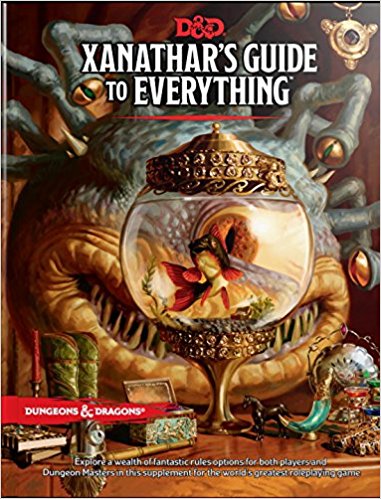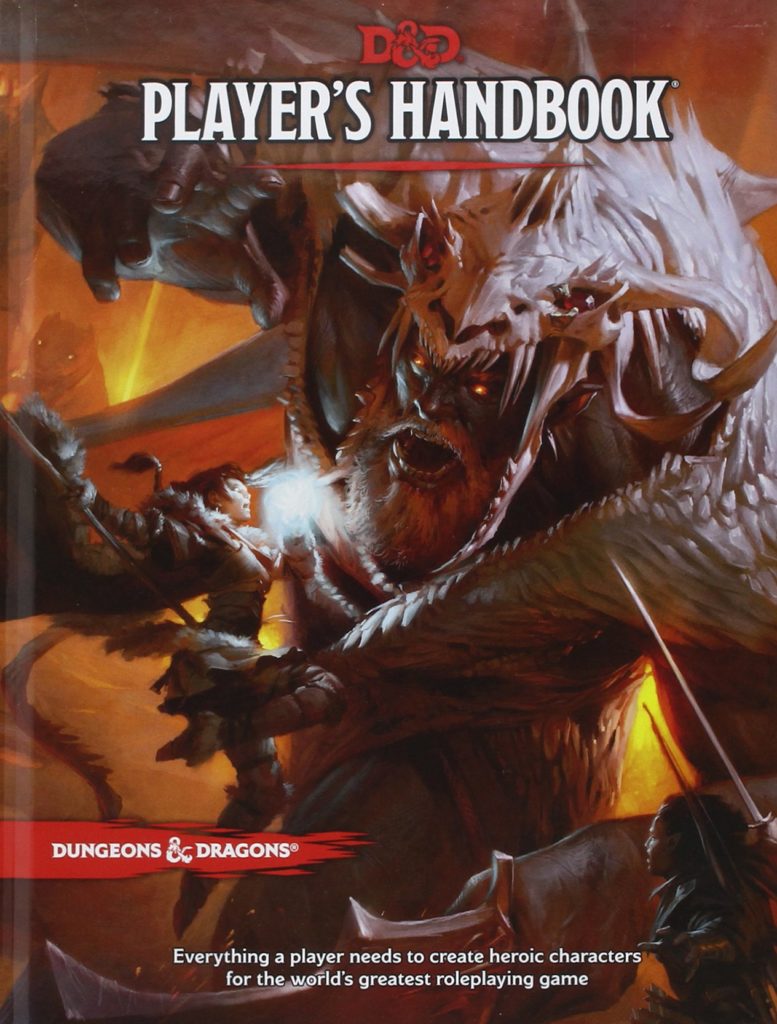
Xanathar’s Guide to Everything for Wizards of the Coast’s wildly popular and successful 5th Edition of the Dungeons and Dragons roleplaying game will have officially hit every retail channel by the time you are all reading this post. If you were lucky enough to have a local gaming store that runs DND Adventurer’s League, you had a chance to get your copy several weeks ago and start looking through the various options. Amazon and other online and brick and mortar retailers were selling it as of November 21st.
While they have had numerous book releases over the lifetime of the game, this book represents the first major release to focus heavily on new player options as well as revisiting some rules from the Dungeon Master’s Guide. And while that is in and of itself an exciting prospect, they managed to take it just one step farther having the book “presented” by Xanathar, a creature well known to those of you familiar with the lore of the Forgotten Realms. Its observations pepper the book in oftentimes amusing sidebars throughout.
 Chapter One covers the player section of the book, with 70 pages devoted to new character options as well as extensive tables to help you generate as expansive a character story as you wish. Each class gets at least one new class option, with many of them getting two to three. If you are like me and pay close attention to the Unearthed Aracana articles that are released, most of these options aren’t new to you, but it’s very nice to see them in print and available for official play now. There is definitely going to be a new path that you will be excited to try at your table. Early favorites of mine are the Path of the Storm Herald for the Barbarian which gives you an aura while you are raging based on which storm archetype you channel – desert, sea, or tundra and the Inquisitive Rogue which makes them master detectives and allows them to use their Sneak Attack ability by studying and understanding their opponents instead of just for catching them by surprise. Each class also includes several additional things to think about in order to differentiate your character from others. What is the thing that could tempt your Paladin away from his Oath? What was your Monk’s master like? And what kind of temple did your Cleric first serve in?
Chapter One covers the player section of the book, with 70 pages devoted to new character options as well as extensive tables to help you generate as expansive a character story as you wish. Each class gets at least one new class option, with many of them getting two to three. If you are like me and pay close attention to the Unearthed Aracana articles that are released, most of these options aren’t new to you, but it’s very nice to see them in print and available for official play now. There is definitely going to be a new path that you will be excited to try at your table. Early favorites of mine are the Path of the Storm Herald for the Barbarian which gives you an aura while you are raging based on which storm archetype you channel – desert, sea, or tundra and the Inquisitive Rogue which makes them master detectives and allows them to use their Sneak Attack ability by studying and understanding their opponents instead of just for catching them by surprise. Each class also includes several additional things to think about in order to differentiate your character from others. What is the thing that could tempt your Paladin away from his Oath? What was your Monk’s master like? And what kind of temple did your Cleric first serve in?
Roughly the last 10 pages of the first chapter are dedicated to a section titled “This is Your Life” which includes table upon table designed to help you generate as expansive and detailed a backstory for your character as you wish. These tables include determining who and what your parents were, where you were born, what your family was like, and why you chose your background and class. Further tables let you explore various life events you may have had based on your character’s age. I haven’t had a chance to sit down and really play with these tables yet, but hearsay from other people say that it’s pretty easy to come up with a cohesive and comprehensive history even from random results.
Finally, the chapter introduces 20 new “Racial Feats” that give you further abilities based on your species selection if you choose them. Like most feats, they’re largely hit or miss, but they can really give you an edge in a particular area or help you to realize a particular character vision. There’s not a bad feat in the mix, but there are definitely some that don’t excite me as much as others do.
Chapter Three is the other chapter that players will get a lot of use out of. Well, about half of them will -this chapter gives us 95 new spells for the eight spellcasting classes to choose from. While many of these spells were printed before in the Elemental Evil Player Companion it is good to see them available for organized play. Two standout favorites of mine are the 7th level Cleric spell Temple of the Gods that allows the caster to bring a temple dedicated to their deity or philosophy into existence for a day, whichncan bar certain creatures from entering or hinder them if they are inside. The temple also protects its occupants from scrying magic. The 8th level Wizard spell Mighty Fortress similarly allows the caster to summon a walled keep staffed by 100 invisible servants from the ground itself that lasts for a week before harmlessly crumbling back into the earth. Both of these spells can become permanent with repeated castings in the same area. There are also four cantrips focused on basic manipulations of the four elements of wind, water, earth, and fire. This of course means that your Way of the Four Elements Monk just needs a level dip in Druid and he can really become a true bender.*

The middle chapter of the book is stuffed full of new and revisited content for DMs. There are numerous clarifications on the basic rules; sleeping, falling, and tool proficiencies all get some love. Spellcasting and areas of effect get some further expansion, focused on how they can be best utilized on a battle grid. Encounter design and trap design get a lot of additional love as well with numerous tables and examples to help a DM make sure they are dialing in the difficulty of their encounters and getting the most out of their traps. Downtime activities get some major revisiting with further expansions and ways to make it more interesting. Finally, the chapter closes with some advice on how to award magical items to the players and devoting some page space to the fact that unlike previous editions, it is not necessary for the characters to gain magical items just to keep up with threats. They are almost always useful and almost always a boon, but they are never necessary. The book then spends a few pages introducing 48 new common magical items for the DM to hand out from the wonderfully useless cloak of billowing that allows the wearer to spend a bonus action to cause it to billow dramatically to the slightly more useful cast-off armor that allows you to doff your worn armor as an action, probably saving your life when you find your boat suddenly capsized while wearing your plate mail or the enduring spellbook that cannot be damaged by fire, water, or the ravages of time.
The book then closes out with two short appendices, one that discusses the idea of Shared Campaigns, similar to organized play for your home groups or clubs. The section spends a few pages talking about things you need to keep in mind regarding adventure length, level advancement, and magical item awards. The final 18 pages of the book are full of names, names, and more names. Within each of the tables within you will find 50 male and female names for all of the races in the Players Handbook (including last names and clan names where applicable) as well as names for humans inspired by many real world cultures.
All in all, if you have a gamer in your life, you can’t go wrong with gifting them with this book. Of course, the book is no good without the core rules. And while the basic rules are available for free online, it doesn’t give access to the same level of options as the Player’s Handbook does, making both of these books powerful gifts for the fantasy roleplayer in your life. Both books regularly retail for $49.95 and can be found at any local game store, many major bookstores, and many online retailers like Amazon or Miniature Market.
*Stay tuned. I’m not sayin’. I’m just sayin’.
